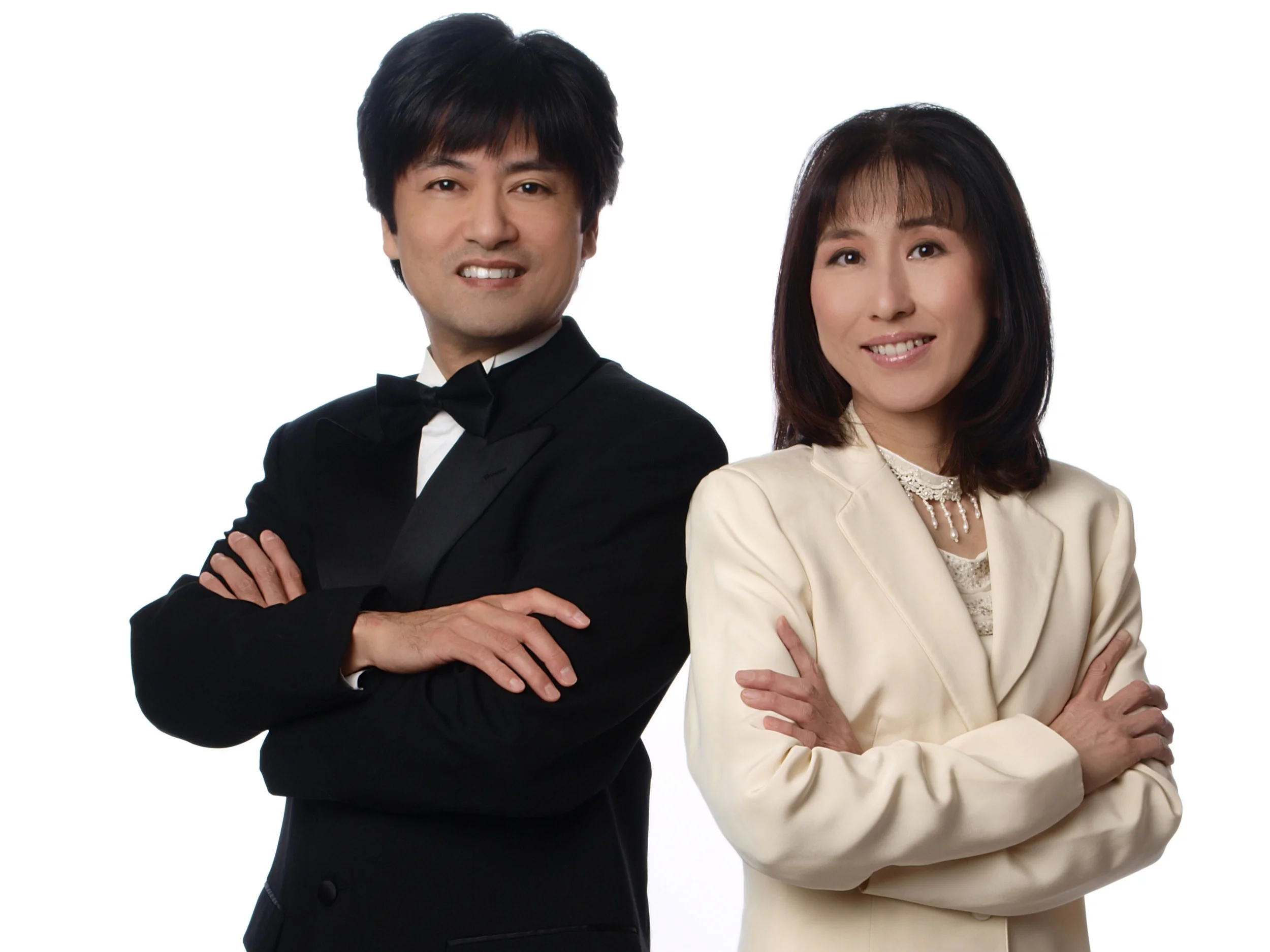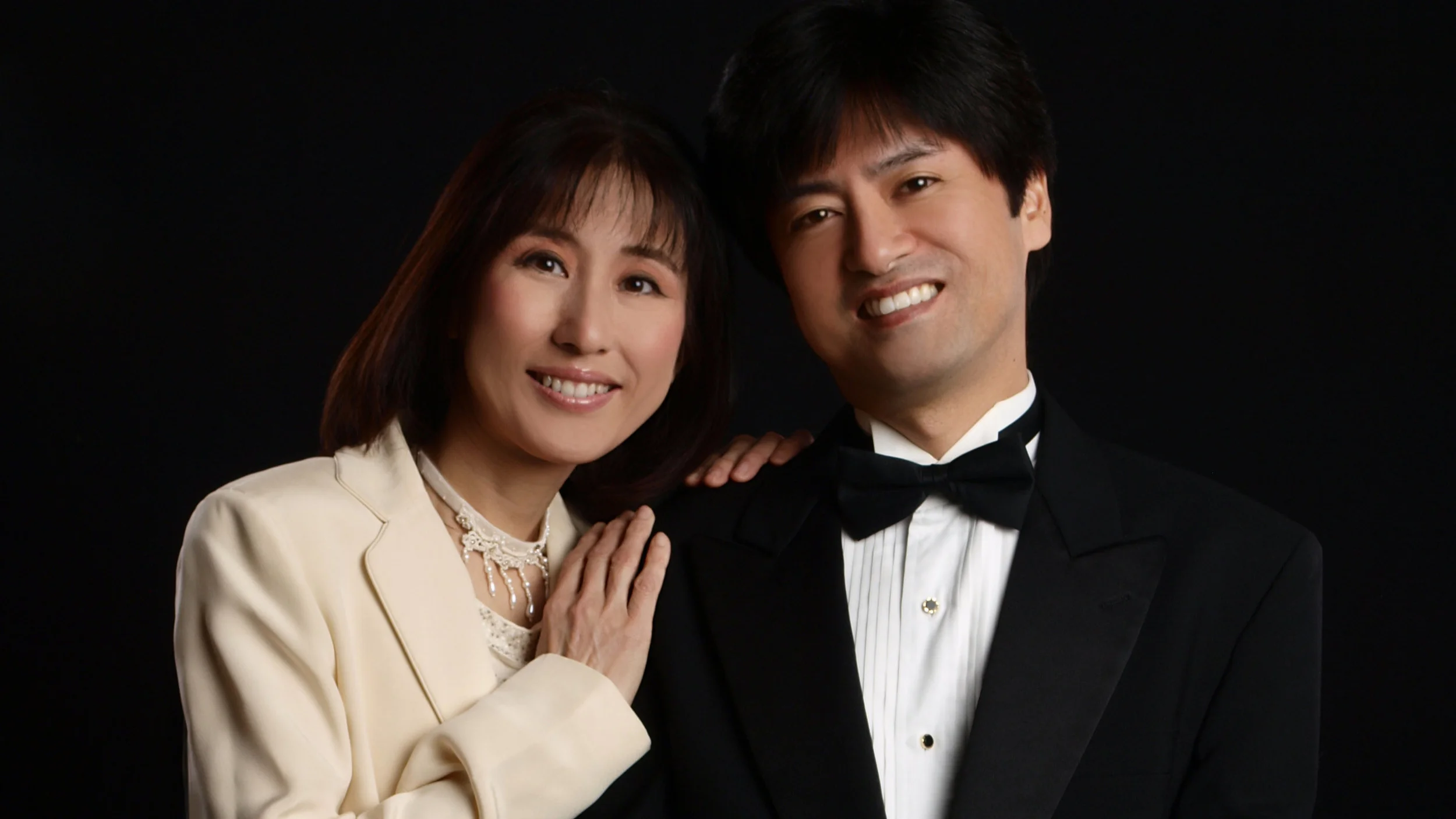SNC:AGO RECITALISTS
Watanabe Organ Duo: April 11, 2008
Husband and wife organ duo Kiyo and Chiemi Watanabe have appeared by invitation at premier events in both the U.S. and abroad, including organ festivals at Spreckels Organ Pavilion in Balboa Park, San Diego, California (1993, 1995, 2000, and 2004), and Iglesia Catedral in Morelia, Michoacan, Mexico (1996 and 2000). Recent performances by the talented couple also include a three-concert tour of Japan.
KIYO WATANABE
Award-winning organist and respected composer Kiyo Watanabe is acclaimed as a performer throughout the U.S. and abroad for his comprehensive musicianship, technical prowess and skilled interpretations. A native of Tokyo, Japan, he has received the 1990 Claire Coci Award and the 1991 Bronson Ragan Award from Manhattan School of Music. Also a respected composer of music for organ, flute, piano, handbells, and choir, Kiyo counts among his credits publication of his works by Abingdon, Alfred, GIA, Harold Flammer, Hope, and Laurendale Associates. Kiyo holds a bachelor's degree in organ performance from Baylor University and a master's degree in organ performance and a doctor of musical arts degree from Manhattan School of Music. Kiyo has served as the organist at First United Methodist Church in Wichita Falls, Texas since November 1996.
CHIEMI WATANABE
Chiemi Yamada Watanabe is recipient of the Bronson Ragan Award for Excellence in Organ Performance. Native of Aichi, Japan, she has appeared in solo performances on many of New York's most historic organs, including those at St. Patrick's Cathedral and Alice Tully Hall at Lincoln Center. She has studied with some of America's premiere organ teachers, including John Weaver at The Juilliard School and McNeil Robinson at Manhattan School of Music, with additional study under Joyce Jones. Chiemi and her husband, Kiyo have served as guest organ professors at Baylor University, where, by invitation, they taught Joyce Jones' students while she was on sabbatical leave. Chiemi holds a master of music degree in organ performance from Manhattan School of Music and a bachelor of arts degree in sociology from Kwansei Gakuin University in Hyogo, Japan. She serves today as organist/music director at Floral Heights United Methodist Church in Wichita Falls, Texas.
PROGRAM
Arrival of the Queen of Sheba: George Frideric Handel (1685-1759)
Handel wrote his famous oratorio Solomon in 1748. Arrival of the Queen of Sheba (I Kings 10:1-13) is an instrumental section from this oratorio. The organ duet version played this evening was arranged by W. Weismann.
Sonata in D Minor for Organ 4 Hands: Gustav Merkel (1827-1885)
Merkel was a pupil of J. Schneider on the organ and of Schumann in composition. The Sonata in D Minor, Opus 30, was the prize-winning composition in an 1857 organ duet competition sponsored by the Deutsche Tonhalle Association. It is broadly conceived in a style influenced by Beethoven, Schumann, and Liszt, and the virtuosic pedal-part is cleverly divided between the two players. Following the precedent set by Julius Reubke in the Sonata on the 94th Psalm, Merkel prefaced each of three movements with a motto from the Psalms (New Living Translation):
I. Allegro moderato (Psalm 42:5, 6, 7, 9)
5. Why am I discouraged? Why so sad? I will put my hope in God! I will praise him again-my Savior and my God!
6. Now I am deeply discouraged, but I will remember your kindness-from Mount Hermon, the source of the Jordan, from the land of Mount Mizar
7. I hear the tumult of the raging seas as your waves and surging tides sweep over me.
9. "O God my rock," I cry, "Why have you forsaken me? Why must I wander in darkness, oppressed by my enemies?"
II. Adagio (Psalm 23: 1-4}
1. The Lord is my shepherd; I have everything I need.
2. He lets me rest in green meadows; he leads me beside peaceful streams.
3. He renews my strength. He guides me along right paths, bringing honor to his name.
4. Even when I walk through the dark valley of death, I will not be afraid, for you are close beside me. Your rod and your staff protect and comfort me.
ill. Allegro con fuoco - fugue (Psalm 42: 11)
11. Why am I discouraged? Why so sad? I will put my hope in God! I will praise him again-my Savior and my God!
Kiara Pig Jig: Robin Dinda (b. 1959)
Robin Dinda is the Professor of Humanities at Fitchburg State College in Massachusetts, teaching various music classes. He has composed hundreds of works for a variety of media. His published works have been performed throughout North America, at many regional and national conventions, and in Europe and Asia. As an organist, he has played recitals across the United States, and is particularly known for his performances of American organ music. Kiara Pig Jig for Two Organists at One Organ was written in 2006. He has written two other organ duets, Max Cat Rag (1997) and Charlie Dog Blues (2004). All of these compositions are titled after his animal pets (Max, Charlie, and Kiara) and based on his original songs he wrote for his beloved creatures. Mr. Dinda writes about his new work for organ duet:
Kiara (kee-ARE-ah) is a tiny, pathetic guinea pig, so I thought it would be fun to write a noisy, bombastic piece completely unlike her. (It ends quietly, though, since duo pieces normally end loudly.) Obviously, it's a fugue based on Bach's Jig Fugue, but in minor. It quotes other jigs, such as "When Johnny comes Marching Home" and "The Irish Washerwoman." Since Kiara is a rodent, I also quoted songs about rodents: "Three Blind Mice," "Hickory, Dickory Dock," and references to the "Mickey Mouse Song." "Pop! Goes the Weasel" (not a rodent, but in 6/8 time) appears towards the end. The melody appearing in bar 36 is a song we made up: "Kiara, Kiara, the mighty capybara." (The capybara is the largest rodent in the world.)
Toccata (from Symphonie Concertante): Joseph Jongen (1837-1953)
Jongen's Symphonie Concertante for organ and orchestra composed in 1926, is a large-scale work of four completely independent movements. This colorful and dramatic work is now among the more frequently performed organ concertos. The dazzling final movement, Toccata, was arranged for organ duet by Kiyo and Chiemi Watanabe.
Variations on an Original Theme: Barrie Cabena (b. 1933)
In 1956, Barrie Cabena became the pupil and friend of Eric Harrison, an English pianist who in his last years was organist at the famous St. Martin's in the Fields, London. Mr. Cabena comments on the writing of the Variations on an Original Theme:
With Mr. Harrison, on many occasions, we played duets and orchestral scores at the piano. After his untimely death in 1970, I wanted to pay him tribute, and a piano duet seemed the obvious form to write in. Some_ years later I arranged the work for organ duet. The truncated ending is an indication of Harrison's uncompleted life, while the prevailing humor is a recollection of his enormous sense of fun.
Les Préludes: Franz Liszt (1811-1886)
Just as Haydn is often called the "father of the symphony;'' so Franz Liszt is usually credited with the invention of the symphonic poem, a type of 19th- and 20th-century orchestral music based on an extramusical idea, either poetic or realistic. The symphonic poem, also called a tone poem, belongs to the category of program music, but the term is usually used for compositions in one movement, in distinction to the program symphony (e.g., Berlioz's Symphonie Fantastique and Liszt's Faust-Symphonie). Liszt wrote thirteen symphonic poems. Les Preludes is the best known of these works, and it is based on a poem by Lamartine. In his preface to the music, Liszt wrote:
What else is our life but a series of preludes to that unknown song of which death sounds the first solemn note? Love is the enchanted dawn of all existence; but what fate is there whose first delights of happiness are not interrupted by some storm, whose fine illusions are not dissipated by some mortal blast, consuming its altar as though by a stroke of lightning? And what cruelly wounded soul, issuing from one of these tempests, does not endeavor to solace its memories in the calm serenity of rural life? Nevertheless, man does not resign himself for long to the enjoyment of that beneficent warmth which he first enjoyed in Nature's bosom, and when the trumpet sounds the alarm: he takes up his perilous post, no matter what struggle calls him to its ranks, that he may recover in combat the full consciousness of himself and the entire possession of his powers.
The four sections of this music evoke different stages of life, and are linked thematically so that we hear the music as a single movement consisting of four contrasting mood-sections. The very first three notes (C falling to B and then rising to E) signal the main theme or motto, which is subsequently heard in various transformations. The first, marked maestoso (majestic), is called "Spring and Love"; then comes the wilder "Storms of Life." Gradually the music calms to a pastoral mood for "Consolations of Nature," in which the theme is given out in gentle woodwind solos ( oboe, clarinet, and flute), and, finally, "Struggles and Victory" has a martial trumpet version of the theme. The organ duet version played this evening was arranged by Timothy Nickel.



